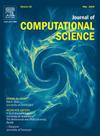Microdroplet dynamics on solid surface: The effect of wetting and surface tension using lattice Boltzmann method
IF 3.1
3区 计算机科学
Q2 COMPUTER SCIENCE, INTERDISCIPLINARY APPLICATIONS
引用次数: 0
Abstract
In this study, we investigated the micro-scale dynamics of droplet impact on solid surfaces with varying wettability, using a 3D modeling approach to capture the intricate behavior of microdroplets. We employed the multi-relaxation times pseudopotential lattice Boltzmann method to simulate the interaction between fluids of different densities, with interface tension playing a key role. The analysis focused on two distinct wetting scenarios: hydrophobic (non-wetting) and hydrophilic (wetting) surfaces, examining the droplet dynamics during both the spreading (propagation) and recoiling phases of impact. By manipulating the bulk modulus parameter κ and the corresponding surface tension γ, we were able to explore how wettability and surface tension influence droplet behavior, including deformation and stability. The study also validated key aspects of our computational framework through reference validations such as contact angle measurements and Laplace's law. Our results provide valuable comprehension of the mixed effects of wettability and surface tension, offering a comprehensive understanding of droplet interactions on different surfaces. This work contributes to the broader knowledge of fluid dynamics and surface engineering, with implications for applications in fields such as inkjet printing, coating technologies, and material science.
固体表面微液滴动力学:用晶格玻尔兹曼方法研究润湿和表面张力的影响
在这项研究中,我们研究了微液滴在不同润湿性固体表面上撞击的微观尺度动力学,使用3D建模方法来捕捉微液滴的复杂行为。采用多松弛时间赝势晶格玻尔兹曼方法模拟了不同密度流体之间的相互作用,其中界面张力起着关键作用。分析集中在两种不同的润湿场景:疏水(非润湿)和亲水(润湿)表面,研究了液滴在扩散(传播)和反冲阶段的动力学。通过控制体积模量参数κ和相应的表面张力γ,我们能够探索润湿性和表面张力如何影响液滴的行为,包括变形和稳定性。该研究还通过参考验证验证了我们的计算框架的关键方面,例如接触角测量和拉普拉斯定律。我们的结果对润湿性和表面张力的混合效应提供了有价值的理解,提供了对不同表面上液滴相互作用的全面理解。这项工作有助于扩大流体动力学和表面工程方面的知识,并对喷墨印刷、涂层技术和材料科学等领域的应用产生影响。
本文章由计算机程序翻译,如有差异,请以英文原文为准。
求助全文
约1分钟内获得全文
求助全文
来源期刊

Journal of Computational Science
COMPUTER SCIENCE, INTERDISCIPLINARY APPLICATIONS-COMPUTER SCIENCE, THEORY & METHODS
CiteScore
5.50
自引率
3.00%
发文量
227
审稿时长
41 days
期刊介绍:
Computational Science is a rapidly growing multi- and interdisciplinary field that uses advanced computing and data analysis to understand and solve complex problems. It has reached a level of predictive capability that now firmly complements the traditional pillars of experimentation and theory.
The recent advances in experimental techniques such as detectors, on-line sensor networks and high-resolution imaging techniques, have opened up new windows into physical and biological processes at many levels of detail. The resulting data explosion allows for detailed data driven modeling and simulation.
This new discipline in science combines computational thinking, modern computational methods, devices and collateral technologies to address problems far beyond the scope of traditional numerical methods.
Computational science typically unifies three distinct elements:
• Modeling, Algorithms and Simulations (e.g. numerical and non-numerical, discrete and continuous);
• Software developed to solve science (e.g., biological, physical, and social), engineering, medicine, and humanities problems;
• Computer and information science that develops and optimizes the advanced system hardware, software, networking, and data management components (e.g. problem solving environments).
 求助内容:
求助内容: 应助结果提醒方式:
应助结果提醒方式:


